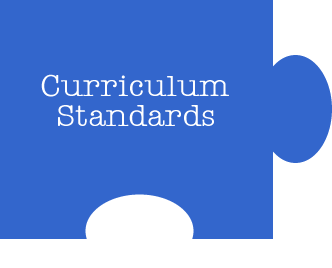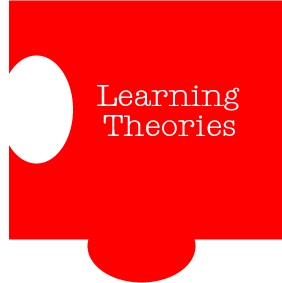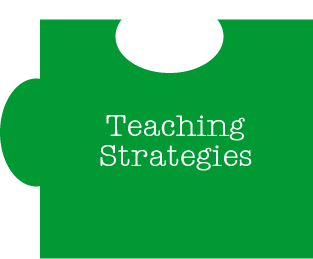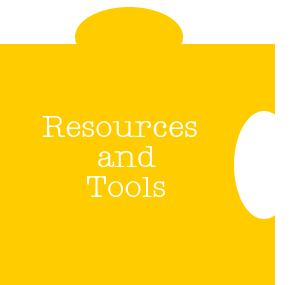The Teaching and Learning Puzzle
The Learning and Teaching Puzzle
Our goal for this semester is to begin putting together the puzzle pieces that make up the learning and teaching process -- with a focus on tools and resources.
 How do educators know what to teach? How do they know what students should learn? Every state has standards and every content area has national standards. There are even standards for technology integration. Georgia is transitioning from Quality Core Curriculum Standards (QCC) to the Georgia Performance Standards. You can even watch a video about the Georgia Performance Standards. You'll also want to be familiar with the ISTE standards for technology integration -- this class, and your course projects, are based on those standards. Select a grade level and subject area that will be the focus of your projects this semester. You'll need to print a copy of these standards and place them in your 3-ring binder for reference purposes this semester.
How do educators know what to teach? How do they know what students should learn? Every state has standards and every content area has national standards. There are even standards for technology integration. Georgia is transitioning from Quality Core Curriculum Standards (QCC) to the Georgia Performance Standards. You can even watch a video about the Georgia Performance Standards. You'll also want to be familiar with the ISTE standards for technology integration -- this class, and your course projects, are based on those standards. Select a grade level and subject area that will be the focus of your projects this semester. You'll need to print a copy of these standards and place them in your 3-ring binder for reference purposes this semester. How do educators know how to meet the needs of the specific learners with which they are working? Are their different types of learners? Does everyone understand subject matter in the same way? How can teachers identify the different types of learners in their classrooms? Take this online quiz to determine your learning style. Find two other classmates who have similar learning styles. Find one learning/study habit that you have in common and be ready to share it with the class.
How do educators know how to meet the needs of the specific learners with which they are working? Are their different types of learners? Does everyone understand subject matter in the same way? How can teachers identify the different types of learners in their classrooms? Take this online quiz to determine your learning style. Find two other classmates who have similar learning styles. Find one learning/study habit that you have in common and be ready to share it with the class.
Here are more resources on learning styles.
Learning Styles Explained
Learning Styles Chart
Learning Styles Self-Assessment
Multiple Intelligence Inventory
But understanding learning styles is just one part of this puzzle piece. Understanding the various learning theories is important to be able to prepare an appropriate learning environment for your students. Read more about learning theories here. How do educators know how to teach? What strategies are used to address certain learning styles? How does learning theory impact teaching strategies? Is lecturing about your subject matter all that is necessary? View descriptions of various teaching strategies here and here. Find two that would suit your learning style. Find at least one classmate who has chosen a similar teaching strategy -- do you have the same learning style?
How do educators know how to teach? What strategies are used to address certain learning styles? How does learning theory impact teaching strategies? Is lecturing about your subject matter all that is necessary? View descriptions of various teaching strategies here and here. Find two that would suit your learning style. Find at least one classmate who has chosen a similar teaching strategy -- do you have the same learning style?
 How do educators pull everything together? What tools and resources do they use to prepare a supportive learning environment? Our main focus for this semester is identifying technology-related tools and resources that support varied student learning styles and teaching strategies.
How do educators pull everything together? What tools and resources do they use to prepare a supportive learning environment? Our main focus for this semester is identifying technology-related tools and resources that support varied student learning styles and teaching strategies.
Preparation for Friday's clas
- Print a copy of the curriculum standards for your chosen subject/grade level.
- Type a response to the questions listed below and turn in a printed copy at the beginning of class Friday.
*Why did you chose this content area/grade level?
*In general, what is the content focus for your grade level?
*What surprised you about your standards?
*What specific standards lend themselves to technology integration? What is it about them that causes you to determine this?
*If you were actually teaching this content area/grade level what would you want your students to know and be able to do? What would be your priorities? What would you want them to remember from your class? - Read the following articles:
http://sh0814.myweb.uga.edu
http://sh0814.myweb.uga.edu
If you don't have time to read the whole chpater, you can skip all the "Insight" sections, such as Insight 3.1 on P.57.
When you read the chapter, think about the following questions.
1. What are the strengths and limitations of directed instructions and constructivist learning models?
2. Give one example of integrating technology respectively into directed instructions and constructivist learning models.
